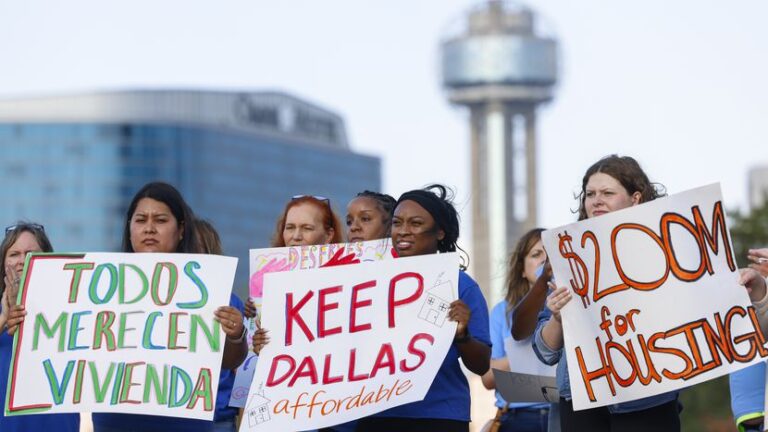Dallas is the latest U.S. city to seek to reform decades-old land-use rules that advocates say limit housing development at a time when affordable housing is in short supply. .
Local zoning regulations limit where homes can be built and at what density. Zoning codes are land management tools that have historically been used to discriminate against low-income and non-white people.
The Dallas City Council is scheduled to address potential zoning reform at a Wednesday briefing, which has been rescheduled after the Jan. 17 session was canceled.
Talk of a zoning change has sparked strong opposition among homeowners in single-family areas, including many residents who spoke out forcefully at a December meeting at Dallas City Hall.
“Please stop this blatant attempt to destroy our single-family neighborhood,” Oak Cliff resident Anga Sanders said at the rally. “Some of us bought what we wanted years ago, and now we are forced by rights to give it up and change our lifestyle, peace of mind, and quality of life.” To do so is contrary to the democratic process.”
But reform advocates argue that the best way for cities to increase housing supply, types of housing such as townhomes and complexes, and affordability is for cities to change development laws and building codes.
Nathaniel Barrett is a local real estate developer who serves on the City of Dallas' City Planning Ordinance Advisory Committee and Comprehensive Land Use Planning Committee.
Barrett said the zoning reforms Dallas is considering, such as reducing minimum lot sizes and allowing mixed-use developments in single-family residential districts, are relatively modest compared to efforts in other cities. .
“These are, in some ways, low-hanging fruit,” Barrett said. “The great thing is that something really small is very achievable and possible anywhere.”
Barrett said lowering the minimum lot area requirements would most likely increase the density of single-family residential neighborhoods and would be least likely to compromise the aesthetic consistency of the area.
Barrett said that as a small-scale developer, he has not embarked on projects that require public hearings through the rezoning process, meaning he can “legally” develop them.
“'Correct' only means that your project will be approved as long as it follows the letter of the law as set out in the city code,” Barrett said. “There is no need to hold public hearings where the project risks being rejected.”
Here's a look at how two Texas cities and the state changed their zoning rules.
The most prominent test case cited by zoning reform advocates is Houston, which is the only major city without ordinances regulating land use.
In 1998, the city relaxed minimum lot size requirements from 5,000 square feet to 3,500 square feet, which dramatically spurred housing development, according to a University of Texas at Austin study sponsored by the Pew Charitable Trusts.
Researchers found that from 2007 to 2020, more than 34,000 townhomes were built, mostly on land previously zoned commercial, industrial, or multifamily.
A UT Austin study finds that minimum lot size requirements increase urban sprawl, reduce walkability and access to transit in cities, and perpetuate racial discrimination.
These reforms will also reduce market pressures that typically lead to further gentrification, said Salim Firth, senior fellow at George Mason University's Mercatus Center and co-director of the Urbanity Project.
“As a result, young people who want to live in cities are buying new homes on the outskirts of wealthier areas, rather than buying flip-flops in poorer areas.'' says Firth.
In December, the Austin City Council voted 9-2 to amend some of the city's zoning rules, allowing development of three units per lot and easing restrictions on small homes.
A mechanism built into both Houston and Austin is the ability for neighbors to opt out by organizing through homeowners or neighborhood associations.
“State law allows homeowners associations to set their own mandates regarding lot size and different types of housing,” said Texans for Texans, a group focused on statewide reforms to expand housing development. said Nicole Nosek, chairman of Reasonable Solutions. “So if someone really doesn’t want a small or moderate lot size in their neighborhood, they can easily form a homeowners association and get out of there.”
Reform supporters in Austin faced fierce opposition from neighborhood associations and homeowners, often labeled as “Not In My Backyard (NIMBY)” sentiment.
“Time and time again, we see the door to homeownership in America shut behind a small number of incumbent homeowners,” Nosek said.
Texas lawmakers considered a number of reforms in the last legislative session aimed at easing housing development.
In a victory for housing advocates, House Bill 14 passed and went into effect in the fall. This allows developers to streamline the occupancy permit process by allowing a third party to review plans instead of waiting for the city's time-consuming permitting and inspection processes.
Elizabeth Markowitz, vice president of public affairs for Texans for Affordable Solutions, said the organization supports passage of the bill as a way to accelerate housing production across the state. He said there was.
“The longer it takes to review these permits, the more it just increases the total cost of the home, which is then passed on to the buyer,” Markowitz says.
Efforts to pass a bill that would override local ordinances and require cities in counties with populations of 300,000 or more to have a minimum lot size of 1,400 square feet for single-family homes were halted due to legislative time.
A bill that would have legally allowed accessory dwelling units to be developed in the backyards of single-family homes failed in the Texas House of Representatives by one vote.
President Joe Biden's administration also announced a series of actions in July aimed at reducing barriers posed by restrictive land use laws. This includes the creation of an $85 million federal program through the Department of Housing and Urban Development that will enable communities to work toward policy reform. Barriers to housing production.

